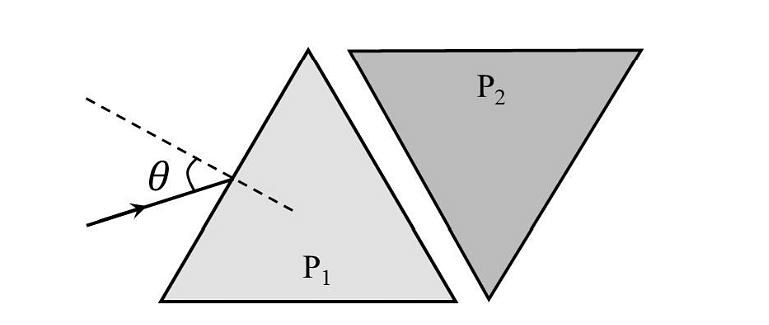Question:
A cell has terminal voltage $2\, V$ in open circuit and internal resistance of the given cell is $2O$. If $4\, A$ of current is flowing between points $P$ and $Q$ in the circuit and then the potential difference between $P$ and $Q$ is
A cell has terminal voltage $2\, V$ in open circuit and internal resistance of the given cell is $2O$. If $4\, A$ of current is flowing between points $P$ and $Q$ in the circuit and then the potential difference between $P$ and $Q$ is
Updated On: Jan 18, 2023
- $30\, V$
- $26\, V$
- $22\, V$
- $24\, V$
Hide Solution
Verified By Collegedunia
The Correct Option is B
Solution and Explanation
Key Point Find the terminal potential difference in case of charging a battery.
According to question, it is the case of charging of battery. So, terminal potential difference is given by
$TPD =V_{P}-V_{R}= E+I_{r}=2+(4 \times 2)$
$=10\, V$ ...(i)
Again, $V_{R}-V_{Q}=4 \times 4=16\, V$ ...(ii)
From Eqs. (i) and (ii), we get
$V_{P}-V_{R}+V_{R}-V_{Q}=10+16$
$\Rightarrow V_{P}-V_{Q}=26\, V$
According to question, it is the case of charging of battery. So, terminal potential difference is given by
$TPD =V_{P}-V_{R}= E+I_{r}=2+(4 \times 2)$
$=10\, V$ ...(i)
Again, $V_{R}-V_{Q}=4 \times 4=16\, V$ ...(ii)
From Eqs. (i) and (ii), we get
$V_{P}-V_{R}+V_{R}-V_{Q}=10+16$
$\Rightarrow V_{P}-V_{Q}=26\, V$
Was this answer helpful?
0
0
Top Questions on Resistance
- If the percentage error in measuring length and diameter of a wire is \(0.1\%\) each, then the percentage error of the resistance of the wire is :
- JEE Main - 2024
- Physics
- Resistance
- Two resistances having coefficient of variation of resistivity \(α_1\) and \(α_2\) are having equal resistance. Equivalent temperature coefficient of resistivity in series and parallel combinations are:
- JEE Main - 2024
- Physics
- Resistance
- The voltage applied across the resistance R is 200+5 and current in resistance is 20+0.2 then find % error in resistance.
- JEE Main - 2024
- Physics
- Resistance
- Find the potential difference across \(700\) \(Ω\) resistance (i.e. Vo)

- JEE Main - 2024
- Physics
- Resistance
Consider the circuit shown. Galvanometer resistance is \(10\) \(Ω\) and current through galvanometer is \(3\) \(mA\). Find the resistance of shunt.

- JEE Main - 2024
- Physics
- Resistance
View More Questions
Questions Asked in JEE Advanced exam
- Let \(S=\left\{\begin{pmatrix} 0 & 1 & c \\ 1 & a & d\\ 1 & b & e \end{pmatrix}:a,b,c,d,e\in\left\{0,1\right\}\ \text{and} |A|\in \left\{-1,1\right\}\right\}\), where |A| denotes the determinant of A. Then the number of elements in S is _______.
- JEE Advanced - 2024
- Matrices
- A block of mass \(5 kg\) moves along the \(x-\)direction subject to the force \(F = (−20x + 10) N,\) with the value of \(x \) in metre. At time \(t = 0 s,\) it is at rest at position \(x = 1 m\). The position and momentum of the block at \(t = (\pi/4)\) s are
- JEE Advanced - 2024
- Work-energy theorem
- Two equilateral-triangular prisms \(P_1 \)and \(P_2\) are kept with their sides parallel to each other, in vacuum, as shown in the figure. A light ray enters prism \(P_1\) at an angle of incidence 𝜃 such that the outgoing ray undergoes minimum deviation in prism \(P_2\). If the respective refractive indices of \(P_1\) and\( P_2\) are \(√ 3 /2\) and \(√3\), then \(\theta = sin{−1}[\sqrt \frac{ 3}{ 2} sin ( \frac{\pi}{B} )],\) where the value of \(\beta\) is ______.

- JEE Advanced - 2024
- Ray optics and optical instruments
- Let \(\overrightarrow{OP}=\frac{\alpha-1}{\alpha}\hat{i}+\hat{j}+\hat{k},\overrightarrow{OQ}=\hat{i}+\frac{\beta-1}{\beta}\hat{j}+\hat{k}\) and \(\overrightarrow{OR}=\hat{i}+\hat{j}+\frac{1}{2}\hat{k}\) be three vector where α, β ∈ R - {0} and 0 denotes the origin. If \((\overrightarrow{OP}\times\overrightarrow{OQ}).\overrightarrow{OR}=0\) and the point (α, β, 2) lies on the plane 3x + 3y - z + l = 0, then the value of l is _______.
- JEE Advanced - 2024
- Vector Algebra
- Let \(\vec{p}=2\hat{i}+\hat{j}+3\hat{k}\) and \(\vec{q}=\hat{i}-\hat{j}+\hat{k}\). If for some real numbers α, β and γ we have
\(15\hat{i}+10\hat{j}+6\hat{k}=α(2\vec{p}+\vec{q})+β(\vec{p}-2\vec{q})+γ(\vec{p}\times\vec{q})\),
then the value of γ is ________.- JEE Advanced - 2024
- Vector Algebra
View More Questions
Concepts Used:
Resistance
Resistance is the measure of opposition applied by any object to the flow of electric current. A resistor is an electronic constituent that is used in the circuit with the purpose of offering that specific amount of resistance.
R=V/I
In this case,
v = Voltage across its ends
I = Current flowing through it
All materials resist current flow to some degree. They fall into one of two broad categories:
- Conductors: Materials that offer very little resistance where electrons can move easily. Examples: silver, copper, gold and aluminum.
- Insulators: Materials that present high resistance and restrict the flow of electrons. Examples: Rubber, paper, glass, wood and plastic.
Resistance measurements are normally taken to indicate the condition of a component or a circuit.
- The higher the resistance, the lower the current flow. If abnormally high, one possible cause (among many) could be damaged conductors due to burning or corrosion. All conductors give off some degree of heat, so overheating is an issue often associated with resistance.
- The lower the resistance, the higher the current flow. Possible causes: insulators damaged by moisture or overheating.



